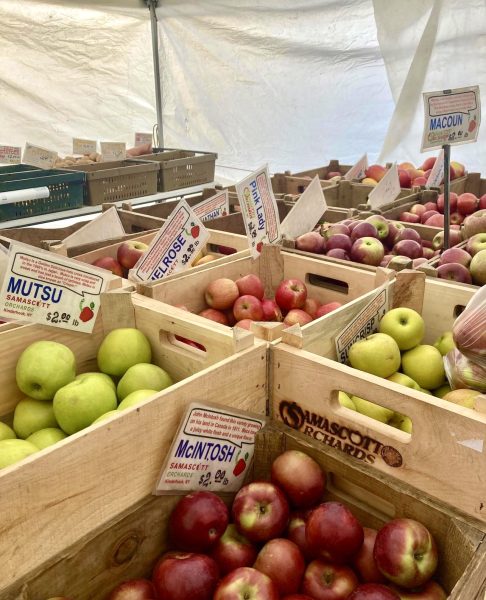How to Make Your Instant Ramen All the Rave
A bowl of ramen is close to the perfect meal. Consisting of savory broth, hearty noodles and a variety of customizable toppings that cover the full spectrum of sweet to salty and soft to crunchy, it can hit all of the major flavor groups. Instant ramen, however, only hits one of those: salty. While good as a comfort dish at the end of a long day, or at the beginning of a very, very early morning, I try to avoid it all other times. If you like instant ramen, I’m sorry. Forgive me. It does not compare to the joy that is real ramen, but there are some tricks that bring it far closer.
As I started this article, I asked my roommate, Madeline Ryan, FCRH ’24, what her suggestions for improving instant ramen are. Within my apartment, she’s the one known to walk into the kitchen with an instant ramen packet and come out a few minutes later with a steaming bowl piled high with toppings. Once, during sophomore year, she baffled one of the cooks at Best Deli with her request for a single, fried egg, which she wanted as a topping for the instant ramen she had bought. Her must haves for good ramen include eggs, vegetables and some form of protein.
After she gave me her suggestions, I corroborated them with some research. Each of the websites agreed with her suggestion of adding some sort of egg, soft-boiled or fried, to the dish, but many had interesting twists of their own.
Budget Bytes suggested cooking your own broth using a jar of Better Than Bouillon stock and water. While this requires purchasing another item to add to your grocery list, Better Than Bouillon jars are typically about five to six dollars, and should make around nine quarts of broth. Bytes also suggested creating your own sauce, using ingredients like ginger, chili, fish sauce and more. That is a bit more intense and also requires stocking your fridge with a lot of ingredients, but for the avid ramen eater it might be worth it. Lastly, Bytes emphasized the importance of adding fresh vegetables.
Serious Eats echoed most of Bytes’ recommendations, but also suggested adding quickly-cooking vegetables like spinach that need no prep as they will cook with the noodles if you add it into the steaming broth. They also suggested dropping an uncooked egg into the same pot in which you are boiling your noodles, which will save both time and dishes. This would only apply to those who decide to cook their noodles outside of the styrofoam cups that ramen often comes in, but for those people it would save time.
Both articles stressed the need to be conscious of sodium levels, as ramen flavor packets tend to include a lot of sodium and adding various condiments into your ramen will only exacerbate the saltiness. Bytes recommended using only half the flavor packet if you intend to add a lot of other sauces, or to avoid really salty additions like soy sauce.
Now comes the experiment, where I tested out these suggestions for myself. To do this, I started in Rams Deli. Although their selection of ramen is not as all-encompassing as Best’s, they have plenty of options to choose from. I got Maruchan Beef Flavor ramen for $1.50, which I’ve had before and did not enjoy. As the seasoning was already covering the noodles, and not in a separate packet, I decided to cook the noodles in the traditional way and add my additions afterwards. I made the ramen following the instructions on the packet, frying an egg while I waited for the water to boil. Once it was finished, I poured the noodles, broth and now rehydrated veggies into a bowl. It looked gross. The broth was watery, the little pieces of corn and beef floated on the sides and it smelled like the ocean. Super gross. I got my additions together, hoping that they would make it a bit more appetizing.
I ended up adding a few pinches of chili flakes, a healthy spoonful of pesto, some sesame oil and sriracha. The chili flakes and sriracha added a nice kick to the broth. I couldn’t really taste the sesame oil, but the pesto… The pesto was amazing. When one of the articles suggested it as an easy stand-in for vegetables, I thought it such a strange idea that I didn’t even think to note it. Then, I saw the jar in my pantry, however, and figured I should give it a try. As I didn’t have time to sauté up any vegetables for my ramen, the pesto made up for this by adding a slight undertone of bitterness that softened the salt’s hard edge. Pesto is a great item to have in your fridge anyway, as you can eat it on crackers or use it as sauce for pasta. If you have it on you, I highly recommend adding a good spoonful of it to your ramen. If not, you might want to invest in some.
For the finishing touches, I dropped the fried egg on top and used the sriracha to add a dash of color. Mixing in the additions and adding an egg transformed something I typically scarf down in the dark hours of the morning into something I savored in the bright hours of midday.
As these additions suggest — but do not necessitate — a stovetop, but also require more expensive ingredients and a fridge in which to store them, I would rate this meal as…
Difficulty level: O’Hare Hall.

Kari White is a senior from the blink-and-you’ll-miss-it state of Delaware. She is majoring in English with a concentration in creative writing, as well...















